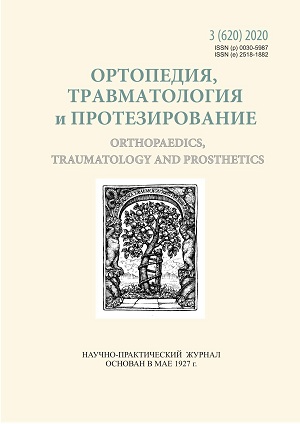Experimental substantiation of the layout of external fixation apparatus for lengthening the tibia in children
DOI:
https://doi.org/10.15674/0030-5987202035-10Keywords:
achondroplasia, leg extension, external fixation apparatus, loadsAbstract
Achondroplasia is a genetically caused disease, which is accompanied mainly by a violation of the growth of the skeleton and limbs in length. Most authors came to the conclusion that it is advisable to carry out the elongation simultaneously on the symmetrical segments, and begin with the legs. At the same time, the authors note a significant number of complications, among which the most severe are the appearance of secondary deformations of the segment during distraction. Objective: to determine the stabilizing capabilities of external fixators (EF) with their various configurations in the experiment on physical models. Methods: an experimental study was carried out on physical models of plastic tibia that was cut in the upper third of the diaphysis. In the experimental group, EF were fixed on the model according to the author’s scheme with a V-shaped arrangement of rods in the proximal tibia (3 models). As a comparison group, we used models with EF, which were fixed according to the «classical» scheme with the location of all the rods in one plane (3 models). All models were tested under axial compressive loads. Bending loads were performed in two planes: parallel and perpendicular to the support beam of the EF. Results: at compression loads of up to 50 N, the displacement of the proximal fragments of the tibia does not have statistically significant differences (p = 0.066). At loads of 100 N or more, the EFs, which were fixed according to the V-shaped scheme, provided smaller displacements of the proximal fragment of the tibia in the diastasis zone compare to EFs with an in-line layout of the rods. At loads of 50 and 150 N, the in-line arrangement of the EF provides a statistically significantly less (at the level of p = 0.001 and 0.019, respectively) displacement of the proximal tibia fragment in the area of EF application of the load than the EF according to the V-shaped pattern. At loads of 100 and 200 N, there is no statistically significant difference between the displacements of the fragments in the both models. (р > 0.2). Under bending loads in the plane perpendicular to the supporting beam of the EF, devices with a V-shaped arrangement provide more stable fixation of the proximal fragment of the tibia than comparative model. Conclusions: the V-shaped arrangement of the EF allows statistically significantly stabilize fixation of fragments of the tibia than the EF with the in-line layout of the rods in almost all the studied loading methods.
References
- Park, K., Garcia, R. N., Rejuso, C. A., Choi, J., & Song, H. (2015). Limb lengthening in patients with achondroplasia. Yonsei Medical Journal, 56(6), 1656. doi: 10.3349/ymj.2015.56.6.1656
- Koczewski, P. (2012). Lower limb inequality treatment with subtrochanteric femoral shortening osteotomy fixed with intramedullary nail. Polish Orthopaedics and Traumatology, 77, 65-71.
- Prеvot, J., Guichet, J. M., Leneveu, E. & Kuhnast, M. (1994). Bilateral lengthening of short lower limbs. 26 cases treated with the Ilizarov method. Chirurgie, 120(6–7), 360-367.
- Lie, C. W., & Chow, W. (2009). Limb lengthening in short-stature patients using monolateral and circular external fixators. Hong Kong Medical Journal, 15(4), 280-284.
- Burghardt, R. D., Yoshino, K., Kashiwagi, N., Yoshino, S., Bhave, A., Paley, D., & Herzenberg, J. E. (2015). Bilateral double level tibial lengthening in dwarfism. Journal of Orthopaedics, 12(4), 242-247. doi: 10.1016/j.jor.2015.05.006
- Koczewski, P., Shadi, M., Napiontek, M., Dorman, T., Faflik, J., Grzegorzewski, A., ... & Zarek, S. (2002). Short stature treatment by lower limb lengthening-multicenter study from five centers. Chirurgia Narzadow Ruchu I Ortopedia Polska, 67(2), 197-206.
- Khmyzov, S. O., Gritsenko, A. V., & Kovalev, A. M. (2009). Rod for external fixation devices. Ukraine. Patent 137575 UA. [in Ukrainian]
- Khmizov, S. O., Pashenko, A. V., Tyazhelov, O. A., Karpinsky, M. Yu., Karpinska, O. D., & Subbota, І. A. (2016). Experimental study of the strength of the primary stabilization of bone fragments using intramedullary fixators of different types. Trauma, 17(5), 40–44. doi: 10.22141/1608-1706.5.17.2016.83874. [in Ukrainian]
- Nasledov, A. (2011). SPSS 19: professional statistical analysis of data. St. Petersburg. [in Russian]
- DSTU ISO 2602: 2006 (ISO 2602: 1980, IDT) Presentation of test results is statistical. Estimation of average value. Confidence interval
Downloads
How to Cite
Issue
Section
License
Copyright (c) 2020 Sergiy Khmyzov

This work is licensed under a Creative Commons Attribution 4.0 International License.
The authors retain the right of authorship of their manuscript and pass the journal the right of the first publication of this article, which automatically become available from the date of publication under the terms of Creative Commons Attribution License, which allows others to freely distribute the published manuscript with mandatory linking to authors of the original research and the first publication of this one in this journal.
Authors have the right to enter into a separate supplemental agreement on the additional non-exclusive distribution of manuscript in the form in which it was published by the journal (i.e. to put work in electronic storage of an institution or publish as a part of the book) while maintaining the reference to the first publication of the manuscript in this journal.
The editorial policy of the journal allows authors and encourages manuscript accommodation online (i.e. in storage of an institution or on the personal websites) as before submission of the manuscript to the editorial office, and during its editorial processing because it contributes to productive scientific discussion and positively affects the efficiency and dynamics of the published manuscript citation (see The Effect of Open Access).














